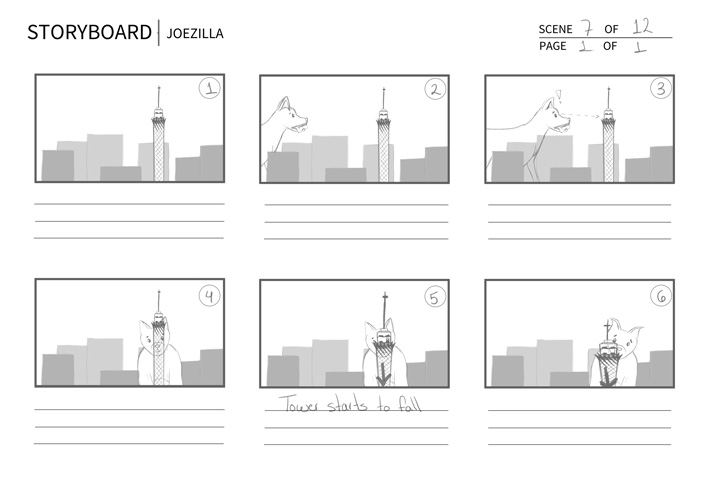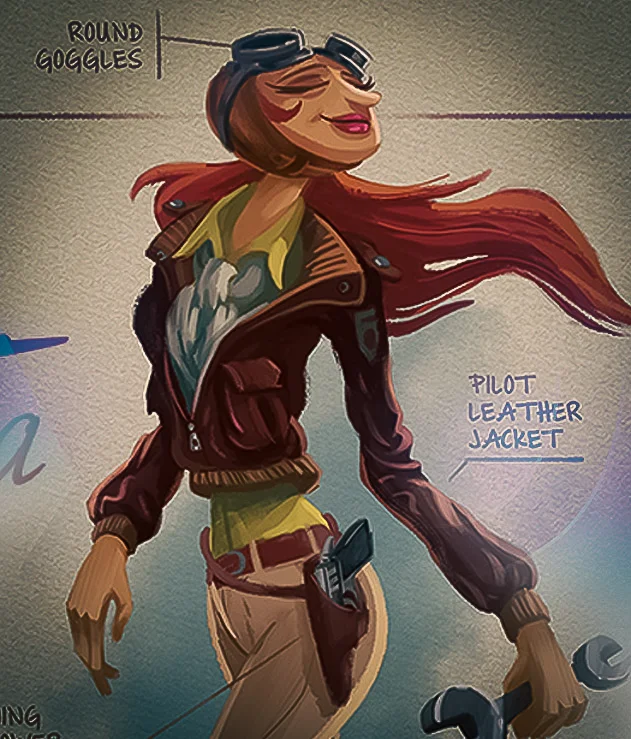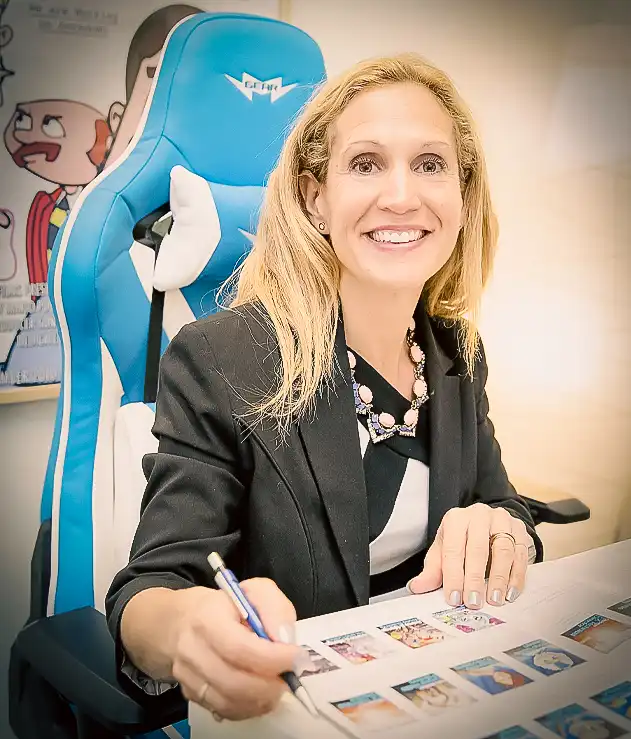 Image credit: Angelica Romero, VANAS student
Image credit: Angelica Romero, VANAS student
How to Become a Storyboard Artist: Step-by-Step Guide
If you have a passion for storytelling and a knack for visual communication, becoming a storyboard artist could be the perfect career path for you. In Canada, the demand for skilled storyboard artists is on the rise as the entertainment industry continues to flourish. From film and television to video games and advertising, storyboard artists play a crucial role in bringing stories to life.
But how do you actually become a storyboard artist? What skills do you need to develop, and where can you gain the necessary training and experience? In this article, we'll guide you through the step-by-step process of becoming a professional storyboard artist in Canada. Whether you're just starting out or looking to advance your career, this comprehensive guide will provide you with the knowledge and resources you need to succeed.
Key Takeaways:
- Canada's dynamic industry offers numerous opportunities for talented storyboard artists.
- Becoming a storyboard artist requires a passion for storytelling and strong visual communication skills.
- Storyboard artists play a crucial role in the entertainment industry, bringing stories to life in various mediums.
- This article will provide a step-by-step guide on how to become a professional storyboard artist in Canada.
- By following this guide, you'll gain a comprehensive understanding of the industry and acquire the skills necessary for success.
Why Choose VANAS Animation School for Storyboard Artist Training
If you have a passion for storytelling and dream of bringing your ideas to life through animation, VANAS Animation School is the perfect choice for your storyboard artist training. With a renowned reputation in Canada's dynamic industry, VANAS offers a comprehensive program that equips you with the skills and knowledge needed to excel in this exciting field.
One of the key benefits of choosing VANAS Animation School for storyboard artist training is our VANAS plus network. As a student, you will have the opportunity to connect with industry professionals, fellow artists, and potential employers through this extensive network. This invaluable resource opens doors to mentorship, collaboration, and job opportunities that can kickstart your career as a storyboard artist.
At VANAS Animation School, we understand the importance of staying up-to-date with the latest industry trends and techniques. That's why our storyboard artist training covers both 2D and 3D animation, ensuring you have a well-rounded skill set that meets the demands of the industry. Our experienced instructors guide you through the process of creating captivating storyboards, teaching you the art of visual storytelling and effective communication through illustrations.
At VANAS Animation School, we are committed to providing our students with the highest quality education and support. Our goal is to nurture your artistic talent, foster your creativity, and help you reach your full potential as a storyboard artist. Whether you aspire to work in film, television, gaming, or advertising, our comprehensive training program will prepare you for success in Canada's dynamic and competitive industry.
Join VANAS Animation School today and embark on an exciting journey towards becoming a skilled and sought-after storyboard artist. Unlock your creative potential, build a strong foundation in storyboard art, and become part of a vibrant community of artists and industry professionals. Don't miss out on this incredible opportunity to turn your passion into a rewarding career!
Developing Skills for Storyboard Artists
Becoming a successful storyboard artist requires a diverse range of skills that allow you to bring stories to life through visual storytelling, illustration, animation, creative direction, and concept development. With these essential skills at your disposal, you'll have the tools to captivate audiences and create compelling narratives.
Visual storytelling is at the core of a storyboard artist's role. You must have the ability to effectively convey narrative and emotion through visual mediums. By crafting compelling compositions, understanding shot types, and mastering the use of visual elements, you can create dynamic storyboards that engage viewers.
Illustration plays a crucial role in storyboarding. As a storyboard artist, you'll need to develop strong drawing skills to bring your ideas to life. From sketching rough layouts to creating detailed scenes, your illustrations should effectively communicate the narrative and capture the essence of the story.
Animation is another vital skill for storyboard artists, as it allows you to visualize movement and timing within a story. Understanding the principles of animation, such as squash and stretch, timing, and anticipation, empowers you to create dynamic and expressive sequences that enhance the storytelling experience.
Creative direction is essential for guiding the overall visual direction of a project. As a storyboard artist, you'll collaborate with directors, art directors, and other key stakeholders to ensure your storyboard aligns with the project's vision. Your ability to interpret briefs, provide creative input, and adapt your artistic style will contribute to the success of the final production.
Concept development is the foundation for any storyboard. As a storyboard artist, you'll need to develop and refine concepts before bringing them to life. This involves brainstorming, researching, and creating initial sketches to establish the visual direction of the story. Strong concept development skills allow you to effectively communicate your ideas and align them with the project's objectives.
By honing your skills in visual storytelling, illustration, animation, creative direction, and concept development, you'll have the foundation needed to excel as a storyboard artist. Whether you're crafting storyboards for film, television, video games, or advertising, these skills will empower you to create captivating narratives that resonate with audiences.
Building a Strong Storyboard Portfolio
Creating a compelling storyboard portfolio is essential for showcasing your talent and expertise as a storyboard artist in today's digital media landscape. A well-crafted portfolio not only demonstrates your skills in visual storytelling but also highlights your proficiency in utilizing various digital media tools to bring your ideas to life.
What Should Your Storyboard Portfolio Include?
- A Diverse Range of Projects: To make your portfolio stand out, include a variety of storyboard projects that showcase your versatility as an artist. This could include storyboards for commercials, films, video games, or animated series.
- Clear Visual Communication: Your portfolio should illustrate your ability to communicate visually. Make sure your storyboards effectively convey the narrative, emotions, and actions of the characters, creating a seamless flow from panel to panel.
- Thumbnails and Rough Sketches: Including thumbnails and rough sketches in your portfolio gives potential clients or employers a glimpse into your creative process. This allows them to see how ideas are developed and refined before the final storyboard is created.
- Attention to Detail: Paying attention to details like composition, framing, and pacing is crucial in storyboarding. Showcase your attention to detail by including examples where you have effectively used camera angles, shot sizes, and transitions to enhance the narrative.
Organizing Your Storyboard Portfolio
Organizing your portfolio in a logical and visually appealing manner is key to making a strong impression. Consider the following tips:
- Categorize Your Work: Group your storyboards according to genre, industry, or medium. This makes it easier for potential clients or employers to find relevant examples of your work.
- Create a Digital Portfolio: In today's digital age, having an online portfolio is essential. Upload your work on a personal website or use platforms like Behance or ArtStation to showcase your storyboards. Make sure your portfolio is easy to navigate and accessible across different devices.
- Keep it Concise: While it's important to showcase your best work, avoid overwhelming your portfolio with too many examples. Focus on quality rather than quantity to ensure a captivating and memorable portfolio.
Showcasing Digital Media Skills
Digital media plays an integral role in contemporary storyboarding. Highlight your proficiency in digital tools and techniques by including examples that demonstrate your mastery of software such as Adobe Photoshop, Illustrator, or storyboarding-specific applications like Storyboard Pro. This showcases your adaptability and ensures that you can meet the demands of the ever-evolving digital landscape.
"A well-curated storyboard portfolio not only showcases your talent, but also communicates your unique creative voice in the digital media industry." - John Wong, renowned storyboard artist
By creating a strong storyboard portfolio that emphasizes your abilities in digital media, you will not only attract the attention of potential clients or employers but also establish yourself as a skilled and sought-after storyboard artist in Canada's dynamic industry.
Gaining Experience and Networking in the Industry
To excel as a storyboard artist in Canada's dynamic industry, it is essential to gain relevant experience and establish a strong network. Here are some strategies to help you on your journey:
- Internships and Apprenticeships: Seek out opportunities to intern or apprentice with established storyboard artists or animation studios in Canada. This hands-on experience will provide invaluable insights into industry practices and allow you to build your portfolio.
- Industry Events and Workshops: Attend industry events, conferences, and workshops to connect with professionals, stay updated on the latest trends, and broaden your network. These events often feature renowned storyboard artists who can provide guidance and mentorship.
- Online Platforms and Communities: Engage with online platforms and communities dedicated to storyboard artists. Participate in forums, share your work, and seek feedback to gain exposure and make connections. LinkedIn and social media groups specific to the animation industry can also be helpful for networking.
- Collaborative Projects: Collaborate with fellow artists or animators on projects outside of your main work. This not only provides an opportunity to expand your skill set but also helps you build relationships and strengthen your network within the industry.
- Showcase Your Skills: Continually refine your portfolio and online presence to showcase your skills as a storyboard artist. Develop a professional website or online portfolio where potential employers and collaborators can easily access your work.
Remember, gaining experience and developing strong connections within Canada's dynamic storyboard artist industry requires persistence, dedication, and a proactive approach. Embrace opportunities, engage with the community, and keep refining your craft to stand out in this competitive field.
Opportunities for Storyboard Artists in Canada
As a storyboard artist, you have a range of exciting opportunities awaiting you in Canada's dynamic industry. The demand for skilled storyboard artists is high, with various sectors relying on their expertise to bring stories to life. Whether you aspire to work in film, television, advertising, or animation, Canada offers a vibrant landscape for your creative talents to thrive.
Let's explore some of the avenues where storyboard artists can make their mark in Canada:
- Film and Television Production: Canadian film and television industries are flourishing, creating numerous opportunities for storyboard artists. You can work on major motion pictures, television series, documentaries, or even independent projects, contributing to visual storytelling at its finest.
- Animation Studios: Canada boasts a robust animation industry, with renowned studios such as Nelvana, Atomic Cartoons, and Mercury Filmworks. Joining these studios allows you to work on various animated projects, including feature films, TV shows, and web series, using your storyboarding skills to breathe life into characters and narratives.
- Advertising and Marketing Agencies: Storyboards play a crucial role in the advertising and marketing world, helping visualize concepts and campaigns. Top agencies across Canada seek talented storyboard artists to collaborate on commercials, digital advertisements, and branded content, offering a chance to work with leading brands and create impactful visual narratives.
- Video Game Development: Canada is a global hub for video game development, with studios like Ubisoft, BioWare, and EA Sports leading the way. Storyboard artists have the opportunity to contribute to the creation of immersive gaming experiences, crafting visual narratives that guide players through captivating storylines.
By tapping into Canada's thriving entertainment and creative industries, you'll discover a wealth of opportunities to grow as a storyboard artist. It's a chance to collaborate with industry professionals, learn new techniques, and showcase your skills on both small and large-scale projects.
Steps to Become a Professional Storyboard Artist
Are you ready to embark on a career as a storyboard artist in Canada's dynamic industry? Follow these step-by-step guidelines to make your dreams a reality:
- Educate Yourself: Start by enrolling in a reputable animation school like VANAS Animation School. Their comprehensive storyboard artist training program covers both 2D and 3D animation, giving you a solid foundation in the craft.
- Develop Your Skills: Hone your abilities in visual storytelling, illustration, animation, creative direction, and concept development. These skills are fundamental to becoming a successful storyboard artist.
- Build Your Portfolio: Create a compelling storyboard portfolio that showcases your digital media skills. Include a variety of projects highlighting your creativity, storytelling prowess, and versatility.
- Gain Experience: Seek opportunities to gain hands-on experience in the industry. Apply for internships, freelance gigs, or collaborate with fellow artists on small projects. This will help you refine your skills and build a network of contacts.
- Network: Connect with professionals in Canada's storyboard artist industry. Attend industry events, join online communities, and engage with like-minded individuals. Networking can open doors to job opportunities and collaborations.
- Submit Your Work: Utilize online platforms like VANAS Plus to showcase your portfolio and connect with potential employers. Create a profile, upload your work, and make yourself visible to industry professionals.
- Stay Updated: Continuously learn and adapt to changes in the industry. Attend workshops, conferences, and online courses to expand your knowledge and stay current with the latest trends and technologies.
Remember, the journey to becoming a professional storyboard artist requires dedication, practice, and perseverance. By following these steps and immersing yourself in Canada's vibrant industry, you can carve a path to success in this exciting field.
Conclusion
Congratulations on completing this comprehensive guide on how to become a storyboard artist in Canada's dynamic industry! By following the step-by-step process outlined in this article, you are well on your way to pursuing a rewarding career in cinematic storytelling.
As a storyboard artist, your skills in visual storytelling and illustration will play a crucial role in bringing narratives to life. The ability to convey emotion, action, and pacing through your storyboards is essential for capturing the essence of a scene and guiding the production team.
Remember, developing your skills as a storyboard artist is an ongoing journey. Continuously honing your craft and staying up-to-date with the latest trends and techniques in animation and creative direction will ensure that you remain competitive in the industry.
By embracing the power of cinematic storytelling, you have the opportunity to make a significant impact in the world of animation and digital media. So take the knowledge and insights gained from this guide and embark on your exciting journey as a storyboard artist!
FAQ
How do I become a storyboard artist?
To become a storyboard artist, you will need to develop skills in visual storytelling, illustration, animation, creative direction, and concept development. It is also important to build a strong portfolio and gain experience through networking and industry opportunities. VANAS Animation School offers training specifically for storyboard artists and can help guide you through the process.
Why should I choose VANAS Animation School for storyboard artist training?
VANAS Animation School is an excellent choice for storyboard artist training because of its VANAS plus network, which provides access to industry professionals and opportunities. Additionally, the school offers comprehensive training in both 2D and 3D animation, allowing you to broaden your skillset and increase your career prospects.
What skills do I need to develop as a storyboard artist?
As a storyboard artist, it is essential to develop skills in visual storytelling, illustration, animation, creative direction, and concept development. These skills will enable you to effectively convey ideas and narratives through your storyboards. Practice and continuous learning are key to honing these skills.
How do I build a strong storyboard portfolio?
Building a strong storyboard portfolio involves creating pieces that showcase your abilities in digital media. Include a variety of storyboard samples that demonstrate your visual storytelling skills and ability to bring characters and scenes to life. It is also beneficial to include some industry-specific projects to highlight your understanding of the field.
How can I gain experience and network in the storyboard artist industry?
Gaining experience and networking in the storyboard artist industry can be achieved through internships, freelance work, attending industry events, and joining professional organizations. It is important to immerse yourself in the industry, make connections, and showcase your work to potential clients and employers.
What opportunities are available for storyboard artists in Canada?
Canada's dynamic storyboard artist industry offers various opportunities, including working in film, television, advertising, gaming, and digital media. Storyboard artists are in demand for their ability to visualize ideas and create compelling narratives through their illustrations. Exploring these industries can lead to exciting career prospects as a storyboard artist.
What are the steps to becoming a professional storyboard artist?
To become a professional storyboard artist in Canada, follow these steps: 1. Develop essential skills in visual storytelling, illustration, animation, creative direction, and concept development. 2. Build a strong storyboard portfolio that showcases your abilities in digital media. 3. Gain experience and network within the industry through internships, freelance work, and industry events. 4. Explore the various opportunities available for storyboard artists in Canada. 5. Open an account at VANAS Plus to access VANAS Animation School's resources and network.
How important is cinematic storytelling in the storyboard artist industry?
Cinematic storytelling is crucial in the storyboard artist industry as it involves creating visual narratives that engage and captivate audiences. Storyboard artists use their skills in visual storytelling to convey emotions, actions, and the overall story through their illustrations. Understanding cinematic storytelling techniques is essential for creating compelling storyboards that effectively communicate the intended message.







